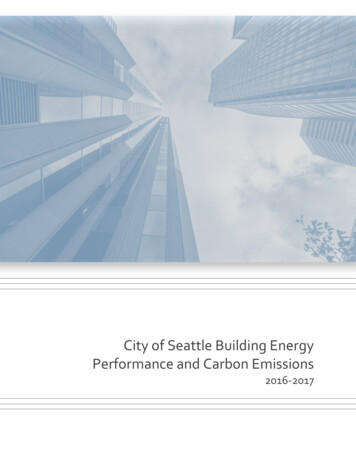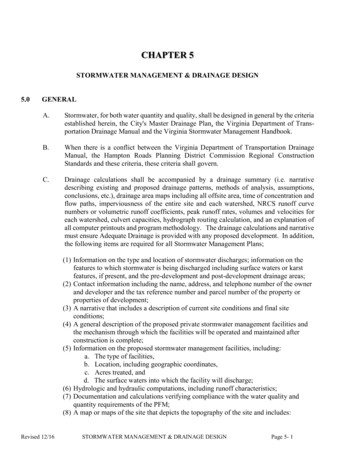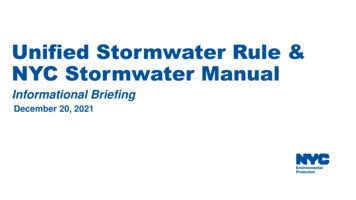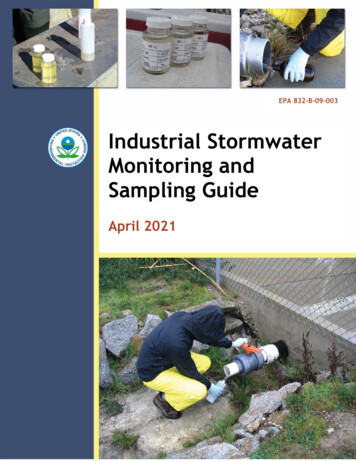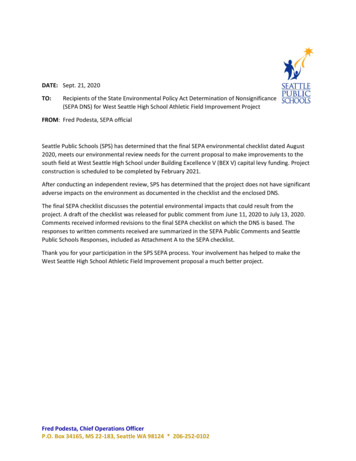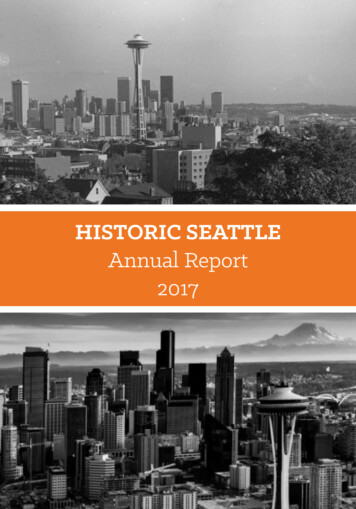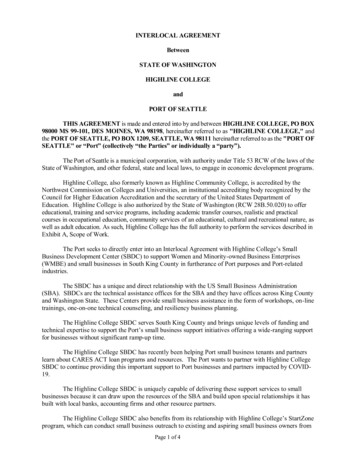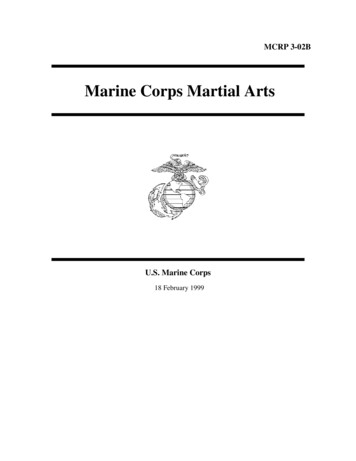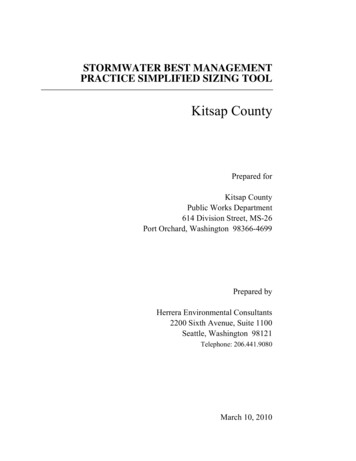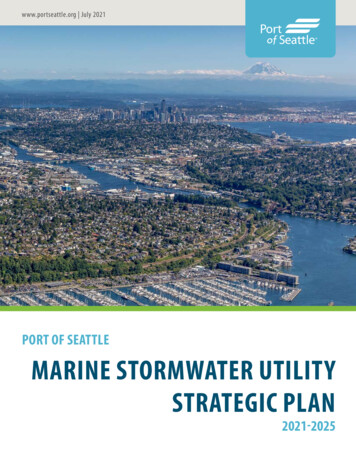
Transcription
www.portseattle.org July 2021PORT OF SEATTLEMARINE STORMWATER UTILITYSTRATEGIC PLAN2021-2025
CONTENTSAcronyms & Abbreviations . . . . . . . . . . . . . . . . . . . . . 3Executive Summary . . . . . . . . . . . . . . . . . . . . . . . . . 4Introduction . . . . . . . . . . . . . . . . . . . . . . . . . . . . . . 5First Five Years, 2014 – 2019 . . . . . . . . . . . . . . . . . . . . 6Accomplishments . . . . . . . . . . . . . . . . . . . . . . . . . . . 8Priorities . . . . . . . . . . . . . . . . . . . . . . . . . . . . . . . . 14Utility Rates . . . . . . . . . . . . . . . . . . . . . . . . . . . . . 18Goals and Strategies . . . . . . . . . . . . . . . . . . . . . . . . 20-2-
ACRONYMS & ABBREVIATIONSBMP . . . . . . . . . . . . . . best management practiceCCTV . . . . . . . . . . . . . closed caption television videoCIP . . . . . . . . . . . . . . . capital improvement projectFT . . . . . . . . . . . . . . . Fishermen’s TerminalGNET . . . . . . . . . . . . . GraniteNetGSI . . . . . . . . . . . . . . . green stormwater infrastructureISGP . . . . . . . . . . . . . . Industrial Stormwater General PermitLMS . . . . . . . . . . . . . . Learning Management SystemMIC . . . . . . . . . . . . . . Maritime Industrial CenterMMPMG . . . . . . . . . . . Marine Maintenance Project Management GroupMM SWU . . . . . . . . . . . Marine Maintenance Stormwater UtilityMS4 . . . . . . . . . . . . . . Municipal Separate Storm Sewer SystemNWSA . . . . . . . . . . . . . Northwest Seaport AllianceO&M . . . . . . . . . . . . . . operation & maintenanceOEDI . . . . . . . . . . . . . . Office of Equity, Diversity and InclusionPM . . . . . . . . . . . . . . . preventative maintenancePort . . . . . . . . . . . . . . Port of SeattleSIAMS . . . . . . . . . . . . . Stormwater Infrastructure Asset Management SystemSOP . . . . . . . . . . . . . . standard operating procedureSPMG . . . . . . . . . . . . . Seaport Project Management GroupSPU . . . . . . . . . . . . . . Seattle Public UtilitiesUtility . . . . . . . . . . . . . Marine Stormwater Utility-3-
EXECUTIVE SUMMARYThe Marine Stormwater Utility (Utility) of the Port of Seattle (Port) was created in 2014 to support meetingor exceeding regulatory requirements for stormwater leaving Port facilities. The Utility operates under a costrecovery model with all revenue used for the stormwater program associated with Port Maritime propertiesmanaged by the Port and by the Northwest Seaport Alliance (NWSA). The first five years of Utility work, 2014to 2019, focused on building the program’s financial backbone, creating policies to document and guide thework, and assessing stormwater infrastructure to obtain baseline data and prioritize future work. During theseearly years, the Port created a cost-effective, innovative, and award-winning utility.The year 2020 provided an opportunity to reflect on our brief history and plan for the Utility’s future. Thisstrategic plan is the culmination of effort by staff, stakeholders and customers to define guiding principles andprioritize our work for the next five years. This plan is intended to move us forward to better serve customersand ensure a resilient Utility while supporting the Maritime industry.To support our guiding principles, defined in mission and vision statements, this strategic plan includes sixgoals with 17 strategies, each with specific tasks.MissionVisionSupporting a sustainable Maritime Industry withinnovative stormwater management that benefitslocal communities and marine life.Leading the way to a clean, healthy and sustainablePuget Sound.Goals:The goals provide focus and efficiency for Utility work to benefit customers and the region while bringingfinancial stability to future rate changes:.1. Maintain and improve stormwater infrastructure2. Reduce stormwater pollution leaving Port properties3. Pursue innovation and new technologies4. Strengthen communications with customers, stakeholders and the community5. Achieve or exceed compliance related to federal, state and local stormwater regulations and legalagreements6. Improve processes within the current financial systemWe intend to revisit this plan each year as the basis for annual business plans that track our progress, and toreview the plan every five years to update or change strategies in furtherance of Utility goals.-4-
INTRODUCTIONThe Port of Seattle (Port) is a special purpose government district founded in 1911 to promote economicopportunities and quality of life in the Puget Sound region by advancing trade, travel, commerce, and jobcreation in an equitable, accountable and environmentally responsible manner. The Port owns and operatesproperties along the Duwamish waterway, Elliott Bay and the Puget Sound, with some portions managed bythe Northwest Seaport Alliance (NWSA). The Port’s vision is to add 100,000 jobs through economic growth, fora total of 300,000 Port-related jobs in the region, while reducing its environmental footprint.The Marine Stormwater Utility (Utility) was initiated in 2014 undera cost recovery model to support the Port in meeting stringentand expanding Washington State and local stormwater regulationswhile benefiting regional water quality. The Utility provides servicesto customers to meet strict local, state and federal stormwaterregulations in support of the Maritime industry. Utility staffcompleted a full assessment of the stormwater infrastructure systemin 2019 to obtain baseline data. This information is used to prioritizeinfrastructure improvements to meet changing needs and addresiliency in an aging system. The Utility installs green stormwaterinfrastructure where feasible to reduce the impact of stormwater onwater quality while adding habitat and beautifying spaces.In developing this Strategic Plan, the Utility incorporated other Portwide efforts and priorities associated with core values and equity. For Tide gate inspection at Terminal 10example, the Port created an Office of Equity, Diversity and Inclusion outfall(OEDI) in 2019 to deepen current Port equity efforts and furthercatalyze organization-wide, systemic change. These efforts were formalized in the Century Agenda to “becomea Model for Equity, Diversity, and Inclusion.” The OEDI created a strategic plan to implement these changes,and the Utility includes equity into our decision making and work practices.In 2020, Utility staff created this Strategic Plan with input from customers and stakeholders to focus futureefforts and support the Port as “the Greenest, and Most Energy Efficient Port in North America.”Core ValuesIn addition to the Port’s values1, the Utility adds the following as core values for our specific work:1CollaborationWork jointly and cooperate with stakeholdersEfficiencyWork effectively to save effort and moneyInnovationCreate unique stormwater treatment, practices and controlsIntegrityAdhere to a code of conduct that supports high standardsSafetyEnsure staff work in ways that avoid harm, injury and lossPort of Seattle Values www.portseattle.org/careers/who-we-are-5-
FIRST FIVE YEARS, 2014 – 2019The idea of creating the Utility began in the late 2000s, was actively discussed by Port leadership in 2012 to2014, and resulted in the official creation on November 25, 2014, by Commission Resolution No. 3696. Muchof the foundational work involved finances, legal issues, and coordinating with the City of Seattle (SeattlePublic Utilities, SPU) on the separation of what was to become two stormwater systems: one managed by thePort’s Utility, and the other by SPU. While the separation was not physical (i.e., the assets are still connectedand discharge to local waterbodies), significant time was spent identifying where one system meets the other,resulting in connection points. There are over 120 connections between the two systems, and additionalpoints are added when identified through infrastructure assessments or other means. We meet with SPUannually to review these connections, highlight changes to stormwater systems including necessary legalagreements, and discuss permit issues associated with regional water quality.One of the first tasks in forming a Utility was creating a financial system to bill and collect revenue so thatbudgets could be developed to perform the work of improving water quality from Port Maritime properties.Our rate categories mirror SPU’s, but at a lower fee and are similar to categories across the industry. The Utilityendeavors to provide essential stormwater services to customers at a better value than when our system was asmall part of the much larger SPU system. This is possible because we now have dedicated funding for the Portstormwater system’s upkeep and operation and maintenance.A second task of the new Utility was to hire staff to run the program. While Port departments and systemsexisted to support the stormwater program, subject matter experts in stormwater and utilities were hiredto lead the program. Existing field staff from the Port’s Marine Maintenance department, who were alreadyperforming stormwater regulatory and operation and maintenance inspections, became part of the newUtility team. Utility office and field staff now total 17 (four office staff and 13 field staff ). The Utility office staffwork closely with Utility field staff to determine and prioritize the Utility’s work, which includes performingbaseline assessments of the stormwater pipes to better understand the extent and conditions of the system,and building upon existing stormwater work to meet or exceed stormwater regulations.Stormwater Utility Team, February 2020-6-
STORMWATER UTILITYBY THE NUMBERSShilshole BayShilshole Bay Marina999.6 acresGreenLakeof drainage area71 miles/374,877 ftBallardBallard Locksof stormwater pipe12Magnolia2,875 catch basinsFishermen’s Terminal223 outfalls197 tenants (Port & NWSA)Terminal 91Queen Anne3Pier 663.4.5.6.Downtown4 Seattle5Elliott BaySmith Cove Cruise TerminalWorld Trade CenterBell Harbor MarinaHarbor Island MarinaTerminal 18West SeattleTerminal 103 6Terminal 1071 mile1.2.3.4.5.6.ISalmon Bay MarinaMaritime Industrial CenterSmith Cove Cruise TerminalWorld Trade CenterBell Harbor MarinaHarbor Island MarinaInternationalDistrictTerminal 46SODOTerminal 30Terminal 5Puget SoundLakeUnion 3,455 drains, filters, vaults, etc.Terminal 86Pier 69 - Port HeadquartersPortof Seattle1. Salmon Bay MarinaProperties2. Maritime Industrial Center881 manholesTerminal 115Terminal 108GeorgetownDuwamishRivSouth Park er-7-Beacon HillRainier ValleyDuwamish RiverPeople’s Park
ACCOMPLISHMENTSSince the Utility’s inception in 2014, the focus has been on improving water quality leavingPort Maritime properties. From meeting regulatory requirements, to maintaining over70 miles of stormwater pipe assets of various condition, to advancing green stormwaterinfrastructure projects, the Utility has many accomplishments in its brief history. The Utilityis proud of its successes in such a short time including: Strong and consistent regulatory complianceComplete system condition assessmentsEffective repair, maintenance and capital improvement programInnovative water quality techniques and green stormwater infrastructure projectsStrong education, outreach and operational partnershipsFinancial stewardship and stability-8-
ACCOMPLISHMENTSRegulatory - Achieve full compliance year after yearThe Port holds a Phase I municipal separate storm sewer system (MS4) permit for Maritime properties thatincludes facilities managed by the Northwest Seaport Alliance (NWSA) and by tenants. Some tenants holdother types of stormwater permits to cover specialized operations, such as Industrial Stormwater GeneralPermits (ISGPs), boat yard and individual stormwater permits, but are universally covered under the Port’sMS4 permit. The Port also holds an ISGP for the Marine Maintenance North Operations site, where vehiclemaintenance and equipment cleaning are conducted. The Utility supports work to meet requirements for theMS4 permit, including updating stormwater pollution prevention plans, training staff, educating customersand general public outreach, inspecting and maintaining the MS4 and annual reporting. Utility staff supportwater quality monitoring for the Port’s ISGP-permitted facility. The Washington State Department of Ecologyissues these stormwater permits and oversees and inspects sites covered under stormwater permits. The Cityof Seattle stormwater codes also apply to Port properties within city limits; King County code applies to thosenot within a city jurisdiction. With a bevy of regulations to follow, we work with customers and review internaloperations and projects to ensure regulatory compliance.The Port’s illicit discharge detection and elimination system addresses illicit connections and discharges tothe MS4, and spill response and reporting is supported by Marine Maintenance Dispatch 24-hour responseline with assistance from Port environmental staff. Utility staff has equipment and expertise to respond to andcleanup spills to the MS4 system.System Assessment - Completed full condition assessment ofstormwater systemUpon inception, a top priority of the Utility was to understand the condition of our assets. To accomplishthis, equipment was purchased to conduct closed caption television video (CCTV) recording for all 70 plusmiles of stormwater pipes between 2016 and 2019. Every condition found, from a small crack, break or rootgrowing through the pipe wall to a full collapse of the pipe, was assigned a score. The pipe asset then receivedan overall score based on all the conditions found across the length of the pipe. We completed this systemassessment at the end of 2019 and now have baseline condition data for all pipe assets, which provides thebasis for prioritizing future work to rehabilitate the stormwater system. Some assets have already met thecriteria for rehabilitation, attaining a specific subset of scores from the condition assessment, without any workperformed. Some assets will need to be cleaned only while other assets will also need a point repair, say to fixa 10-foot break in a 100-foot long pipe, or entirely replaced to meet the criteria for rehabilitation.Camera used for pipe assessmentsCCTV truck cockpit-9-
ACCOMPLISHMENTSPipe Repair - Over 60 critical pipe repairs completedAs a result of assessments, over 60 pipesegments were identified as requiringimmediate repair (score of 90 or above)because they were unusable for conveyingstormwater or created safety risks frompotential holes forming above voids. Utilitystaff excavated and repaired these assetsas soon as feasible under an urgent repairprogram. In total, we completed theseurgent repairs between 2017 and 2020 toensure continual and safe Port operations.Screenshot from assessment video showing full pipe collapseOutfall Rehabilitation - Installed 21 tide gate valves to protect the system frominundationBecause our stormwater conveyancesystem directly discharges through outfallsinto regional waters, outfall rehabilitationbecame another important focus of initialwork. Some outfalls lie below high tide,and as tides rise, river, bay and soundwaters can enter the stormwater system.This causes two major concerns: thesystem can flood parts of a facility, andcorrosion and biological growth increaseswithin the pipes. To limit tidal influenceon the stormwater system, the UtilityPipe repairinstalled tide gate valves (or tide valves)on outfalls. A tide valve remains closed,keeping receiving waters from entering thesystem, and only opens when pressure builds from upstream flows. Through 2020, we installed 21 tide valvesthroughout the stormwater system.- 10 -
ACCOMPLISHMENTSGreen Stormwater Infrastructure – Delivering resiliency to stormwatermanagementThe Utility strives to go above and beyond stormwaterregulations by incorporating green stormwaterinfrastructure and treatment systems in areas wherethey are not required by regulation or codes. ThePort also participates in Salmon-Safe third-partycertification for Maritime parks and public accessareas and has been certified since 2008. Stormwaterand habitat projects are two important elementsin maintaining Salmon-Safe certification , a leadingmovement to help Pacific salmon thrive.Installing tide valveTerminal 86 Bio-filtration Facility – TheUtility’s first bio-filtration facilityA ponding problem on the Centennial Park bike and pedestrian trail near Terminal 86 provided theopportunity to develop the Utility’s first in-ground bio-filtration (rain garden) facility. Rather than simply regrading and altering a stormwater pipe to reduce ponding at a busy junction in the trail, the Utility evaluatedand installed a small rain garden to remove potential pollutants. This added bio-filtration treatment to thestormwater infrastructure, and since it is in a busy public area, provides a visible location for educationalsignage about rain garden functions.Bio-filtration facility along Centennial ParkSignage posted adjacent to Rain garden explainingbenefits to the environment- 11 -
ACCOMPLISHMENTSTerminal 102 Downspout Oyster Shell Treatment Barrels – Innovative solution to treatstormwater pollutionOyster shells, which bind heavy metals such aszinc and copper, are used to treat stormwaterfrom roof runoff at Terminal 102 commercialbuildings. Zinc and copper are detrimental toaquatic life, particularly endangered salmon. Theoyster shells are contained in barrels connectedto roof downspouts, and as stormwater flowsthrough, heavy metals and sediment arecaptured. The oyster shells are changed outeach year since effectiveness decreases overtime. Typically, newly purchased shells are used,but in September 2020, oyster shells that hadbeen in the barrels were ‘refreshed,’ employing amedia washing machine invented by Utility staff Oyster Barrel and sign at T102and built by Marine Maintenance. To evaluatetreatment effectiveness, water samples arecollected, and pollutant levels analyzed from water that enters and leaves the barrels. Data show a 30% to 50%reduction in metal concentrations.In addition to Terminal 102, oyster shells are used in stormwater treatment at Terminal 46, Marine MaintenanceNorth Operations and Terminal 5 Transit Shed. The media washing machine helps reduce the amount of newoyster shells purchased and increases longevity of the shells in use.Splash Boxx – Portable planter boxes forcommercial and industrial locationsIn 2014, the Port installed two ‘Splash Boxx’ systems atTerminal 91 to treat runoff from a building with a galvanizedroof. Galvanized metal may leach zinc. The Splash Boxx bioretention system was initially studied as part of a King CountyConservation District funded ‘Moving Green InfrastructureForward Project.’ In 2019, the Port moved these boxes to treatstormwater at two locations: a roof at Maritime IndustrialCenter (MIC), and the Marine Maintenance Horton Streetsouth parking lot. This placement of the two systems allowscomparison of bio-retention media treatment from differentuse areas. The soil media is a custom mix of sand, wood chips,and biochar and planted with native, drought tolerant plants.The inflows and outflows are monitored to determine removaleffectiveness of zinc, copper, and turbidity. Initial Splash Boxxresults reflect 60 to 70% reductions in copper and 85 to 90%reductions in zinc. Average reductions in turbidity for thelonger established system were 70%.- 12 -Flowers growing in the Splash BoxxSplash Boxx at MIC
ACCOMPLISHMENTSAwardsThe Utility won two American Association of Port Authorityenvironmental awards in 2017 and 2019. In 2017, we won theComprehensive Environmental Management award for the“Formation and Operation of the Marine Stormwater Utility,”which summarized the efforts to create the Utility and thefirst few years of work. In 2019, we won the EnvironmentalEnhancement category award of excellence for the “InnovativeStormwater Operations and Treatment Techniques.” Thisapplication detailed three techniques developed by the Utility,and by the Port before the Utility was created, including a dockscrubber that recovers wash water with a vacuum, oyster shelltreatment barrels to treat roof runoff, and the media washingmachine that refreshes used oyster shells for reuse in stormwatertreatment systems.Dock scrubberThe media washing machine also won an internal port-wide innovation award for 2019 quarters one and two,and the annual 2019 award and the people’s choice award by Port employees.Media washing Machine- 13 -
PRIORITIESThe primary focus of the Utility has been to improve water quality in support of the Port’sCentury Agenda strategy to be the greenest, and most energy efficient port in NorthAmerica. Our vision and mission continue with and align with this aspirational goal. Inorder to be the greenest Port, the Utility has prioritized five key areas: Infrastructure;Sustainability; Climate Change; Equity, Diversity and Inclusion; and Habitat.- 14 -
PRIORITIESInfrastructureOne basic function of the Utility is to move stormwater runoff from facilities through conveyance systemsto receiving waters. A complex infrastructure of pipes and structures performs this essential functionthroughout Port facilities. The first step was to understand the details of the system, including pipe locations,characteristics and conditions, from our completed assessment program. The next step will be to rehabilitatethe aging system over time to continue this function but also add components such as green stormwaterinfrastructure and innovative treatment to remove pollutants and continually improve regional water quality.As a core value, innovation is at the root of our work and helps to meet our vision of leading the way to a clean,healthy and sustainable Puget Sound.To rehabilitate our stormwater system as guided by the Port’s Century Agenda, we will need to repairor replace many existing stormwater pipes through excavation or trenchless technologies, install newstormwater systems, add treatment systems, install green stormwater infrastructure and continue innovating.This work will continue for years to come but prioritization using the data from the assessment program, aswell as continuing reassessments will be the key to proactively upgrade the infrastructure.Sustainability FrameworkIn 2019, the Port developed a sustainable project framework to evaluate all Port capital improvement projects.The framework includes lifecycle consideration for energy, habitat, waste, and stormwater. Capital projectsare screened and placed into three different categories that apply increasing levels of effort to maximizesustainability and environmental benefit. Stormwater is one of eight categories in the framework and Utilitystaff help evaluate projects and participate on project review teams to ensure compliance with regulationsand approve of changes to the stormwater system.Climate Change/Resilience PlanningClimate change and resilience are complex and emerging issues, and the Port has identified this as a highpriority for the future. The Port drafted a climate adaptation plan in 20152 to address rising sea levels andintensifying storms and fulfill the Port’s role as a steward of the environment and maritime industry. One keyresult is that the stormwater system is not currently capable of handling sea level rise. The Utility will updatethe plan to address specific elements for stormwater infrastructure adaptation and resilience consideringregional efforts by the City of Seattle, King County, and Washington state. Another element of the Port’sclimate change planning is greenhouse gas reduction targets that align with the Paris Climate Agreement.These targets include an interim goal to cut emissions in half by 2030. The targets also entail a long‐rangecommitment to deeply “decarbonize” maritime activity and make Port operations carbon neutral or carbonnegative by 2050.Evaluating how climate change will impact our stormwater infrastructure, water quality, and other Portconcerns and to plan accordingly is a long-term endeavor. Phasing in system resilience will require in-depthanalysis and access to data being compiled by other local, state, federal and international entities. We willcollaborate with other Ports and government organizations grappling with this to maximize efforts inaddressing the impacts of climate change on coastal communities and the maritime industry. We don’t havethe answers on climate change or sea level rise, but we can ensure our system is built to adapt to changes tocontinue to serve our customers and the maritime industry.2Port of Seattle. June 19, 2015. Climate Change Adaptation Plan for Port of Seattle Waterfront Properties.- 15 -
PRIORITIESEquity, Diversity and InclusionUnderstanding how the Utility can address the needs of diverse and historically marginalized communities,from underfunded neighborhoods in the Duwamish Valley to Indigenous peoples who have treaty rightsto lands and waters that the Port abuts, is a long-term endeavor. Water quality and pollution preventionare important issues for the region, and Black, Indigenous, and other communities of color often sufferdisproportionally from pollution. The University of Washington Department of Environmental andOccupational Health Sciences has created a map3 showing health disparities based on living and economicconditions. Identifying opportunities to improve water quality for these communities will involve directcommunity engagement, some of which is occurring through the Port’s habitat, energy and communityenhancement projects.The Port’s OEDI is developing an equity tool to look at historically marginalized communities within the KingCounty region. This tool evaluates the entire region and provides a score for each census block group. Thisscore gives a numeric value to the disparities within the community. Utility staff will collaborate with the OEDIteam to ensure that equity continues to develop as an underlying principle of the work we do.Habitat CollaborationWhile the Port has a dedicated habitat team working to restore degraded sites, address habitat andremediation mitigation requirements, and create shared spaces to benefit people and the environment,there are potential interconnections between habitat and stormwater efforts. The Utility and habitat teamscollaborate on ongoing and new opportunities that include Salmon-Safe recertification and potential forstormwater-habitat interface and benefits at Port facilities.t̓ uʔəlaltxʷ Village Park and Shoreline Habitat n-environmental-health-disparities-map-project- 16 -
PRIORITIESDuwamish River People’s Park and Shoreline Habitat RestorationReplacing stormwater treatment media in vaults at Terminal 46- 17 -
UTILITY RATESThe Utility operates on a cost recovery model, and the revenues fund the entirety of thestormwater regulatory and infrastructure program. Bills paid by customers are investedin infrastructure and services to improve water quality, including daily operations,regulatory maintenance, infrastructure assessment and repair, and capital projectsincluding green infrastructure.- 18 -
UTILITY RATESRates are adjusted each year by reviewing the baseline budget against forecasted spending, typically fiveyears out, and anticipating revenue for the current year. Planning work for the coming year includes newcapital projects, increased levels of service to benefit customers, and cost reductions from streamliningoperations. A new rate is calculated for this total expenditure. The forecast budget is presented to the Utility’sRate Advisory Committee, which includes Port and NWSA executives, who provide valuable insight andrepresent Maritime business operations and tenant interests. The Committee provides recommendations for aproposed Utility rate, which is then presented to the Port Commission for final approval before adopting newrates for the coming year.The table below shows the projected rate path approved in 2020 for the next five years. The rates are subjectto Port of Seattle Commission approval annually.RATE PATH20212022202320242025AVERAGESWU Rate Increase3%4.6%4.6%4.6%4.6%4.28%Since the inception of the Utility, it is a priority to keep our rates lower than SPU to provide customers financialsavings while delivering additional services such as proactive infrastructure assessment and repair. The Utilityis now able to maintain and improve stormwater infrastructure, which benefits regional water quality, at alower rate than we previously paid SPU. The graph below shows a comparison of the drainage rates for the“very heavy” rate category for the Port’s Utility and SPU.- 19 -
GOALS AND STRATEGIESThe Utility began work on a strategic plan in late 2019. The effort evolved over sixmonths with assistance from a consultant, Veda Environmental, and a core team thatplanned and developed material for an internal workshop. The purpose of the workshopwas to engage stakeholders in creating the strategic vision, mission, and to identifyingpriority goals to guide the work during the lifetime of this plan in support of the visionand mission for the future.- 20 -
GOALS AND STRATEGIESTo gather information and lay groundwork for the workshop, two surveys were developed to gather inputfrom stakeholders: one for Port Utility and environmental staff, and another for external customers and Portreal estate staff. The overall response rate was 45% and this information provided key input f
GSI green stormwater infrastructure ISGP Industrial Stormwater General Permit . is a special purpose government district founded in 1911 to promote economic opportunities and quality of life in the Puget Sound region by advancing trade, travel, commerce, and job . Rainier Valley Beacon Hill Port of Seattle Properties STORMWATER UTILITY BY .
